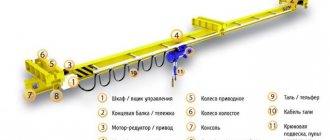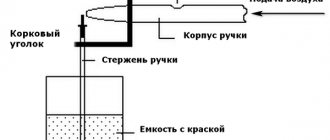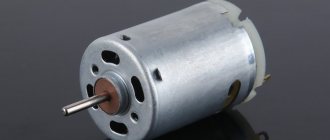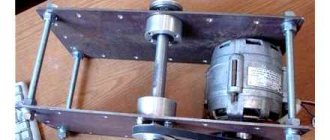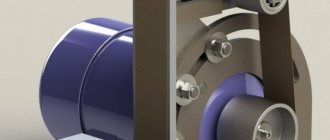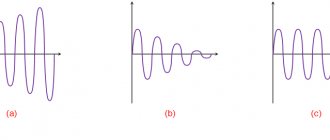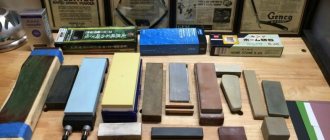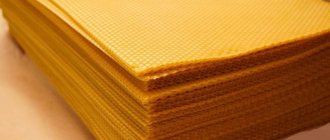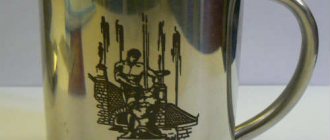Causes and signs of stator failure
Hand-held grinders, popularly called “grinders,” can fail for various reasons.
The most common problem is the breaking of stator turns, which occurs due to too much load on the device. Now you can correct such a malfunction yourself - rewind the stator correctly. There are often cases when the cause of a breakdown is the failure of the electrical part of the device. Various factors lead to this:
- water entering the surface through which the current passes;
- power surges;
- abruptly pulling the plug out of the socket;
- high overloads and, as a result, overheating.
There is an opinion that it is impossible to rewind the stator yourself. In fact, it is enough to understand the design of the device. If you have experience in such work and the necessary knowledge, you can repair a three-phase starting device at home. Given the preparatory work, the process may take several hours.
Wire winding diagram.
Often the engine fails due to a break in the magnetic circuit, damage to the winding or armature commutator. As the voltage increases, there is an abrupt increase in spark strength. This is usually observed on only one brush. This phenomenon leads to the destruction of the wire insulation on the stator coil. If, when turned on, the disk accelerates very quickly and gains speed, this indicates a turn short circuit in the stator.
Sparks that occur during operation of the collector signal the occurrence of disturbances in the balancing of the armature. Checking the operation of the collector can be done in this way: when turned on, the sound should increase gradually with increasing voltage. There should be no vibrations. If resonance is observed, the electric motor of the angle grinder requires repair.
Types of electric motors and repair features
These devices are produced in different designs. Winding failure in industry is repaired by sending the engine to a repair shop, where the engines are disassembled, cleaned, and inspected.
Then they try to rewind the faulty windings using special winding installations
. After this, the engines are assembled and tested at operating speeds, measuring no-load current and under the expected load.
Electric motors are divided into two types:
- motors with a squirrel-cage rotor are easy to manufacture, inexpensive and have a high efficiency factor;
- with a wound rotor, this design solution is used when the supply voltage is insufficient, if this power is not enough to start the device.
Malfunctions of such devices in everyday life are eliminated together with the service department or by taking the motor to a workshop. But what to do if there is no service nearby and there is no opportunity to send it to professionals for repairs?
The only option is to try to disassemble it at home and rewind it yourself. with minimal knowledge can rewind the windings
about the method of rewinding.
Disassembling the electric motor
Before disassembling, it is necessary to wet clean the motor, then clean it with a rag. Unscrew the fan cover
, remove all the bolts sequentially. After this, we compress the fan, having first unscrewed its fixing bolt.
Unscrew the stand fasteners
and fastening of flanges. Disconnect the motor connector with the terminal block. All fasteners and bolts must be folded separately so that there are no problems with assembly later. We unscrew the front flange together with the rotor and pull it out.
The different design of electric motors makes you think in advance: “Which winding has failed, the rotor or the stator.” Using ohmmeter and megohmmeter
We check the windings.
We test the motor with an ohmmeter between the three phase terminals to ensure the same resistance. We check each phase to ground with an ohmmeter; the resistance should be on the order of several megohms or higher. Then we take a megohmmeter and check the insulation resistance
each winding to the housing.
We have identified the faulty winding; in our case, the stator winding is faulty
, and the rotor has a non-separable design. Dismantling the stator is not quite a simple task, as it might seem at first glance.
If the winding has melted very badly and the electric motor has failed due to overheating, then there is no need to knock it out; it can be removed quite easily
from their mounting points. It so happens that the winding is slightly burnt or is broken, then the varnish will hold very well, and even attempts to knock it off with a chisel will not lead to complete removal of the old parts.
Alternatively, you can light a fire and heat the stator housing
so that all the varnish inside burns out. After such actions, the old deposits will fall out on their own.
It is necessary to allow the case to cool in air without resorting to liquid cooling, otherwise the case will not withstand the temperature difference
and it will crack. Cleaning of the inner surface is required until it is shiny. There should be no scale left from the melted varnish and copper.
You will need to count the number of turns and wire parameters. the winding wire for rewinding
. This wiring has special properties. They come in round and rectangular shapes.
Wiring has very low insulation resistance
. In repair shops there are mechanical devices for winding windings, wires are taken with increased insulation strength, the letter M is added to the marking. We do the rewinding ourselves, so we will take a wire with ordinary insulation with parameters corresponding to the previous one.
Checking the electric motor after repair
Next we carry out the verification procedure. First, you need to “ring” the device again, as described at the beginning of the article when diagnosing the problem. It is necessary to exclude the possibility of breakage, lack of contact and short circuit of any kind. If the engine passes these checks, it's time to start testing for functionality. To do this, do not immediately connect it to the existing power supply. In industrial facilities, the voltage is 380 V. This is quite a lot. Using a step-down transformer, you should test the operation of the motor.
If it rotates without problems and does not smoke, then the job was done correctly. The engine can be used for its intended purpose.
Thus, the instructions for rewinding an electric motor at home are complete. Good luck to everyone in your new achievements!
Electric motor scrap price
Electric motors for scrap
The price for scrap electric motors may depend on: the number of motors, the amount of work that needs to be done to crush the electric motor housing and perform the separation of non-ferrous and ferrous metals.
If there are many engines, then it is more cost-effective to separate copper and cast iron (electric motor housing). To do this, you can hire a person who will chop the hulls with a sledgehammer, and another will extract copper. It all depends on the number of engines. If there are a lot of them, then the work may take several days, while wage costs will be scanty - 1500-2000 rubles per day, and the income received from copper and cast iron will ultimately more than cover all costs.
Electric motor scrap, the price of which is determined by the weight and power of the engine, as well as its design, is an important source of supply of raw materials of ferrous and non-ferrous metals to metallurgical mini-plants.
Check and enable
Before starting the engine for the first time after repair, it must be thoroughly checked. To begin with, all inserted “coils” ring. This will help you find out if there is a break or poor contact. The resistance is measured between the “layings” so that a short circuit does not occur when turned on.
You should not immediately supply 220 V to the engine; it is better to supply a reduced voltage. Let the rotor spin slowly, the main thing here is to find out if the engine is overheating. If everything went well and no smoke appeared, then the engine repair was successful.
There are many photos on the Internet on rewinding motors. This will help beginners visually familiarize themselves with the process.
Wire selection
Ideally it should be exactly the same. But this doesn't always work out. Consequently, you will have to use a material with a different cross-section, which occupies an adjacent position in the corresponding table. In this case, you need to remember Ohm's law and take into account that as the diameter of the wire decreases, its resistance increases.
This means that it will be necessary to change the number of turns, for example, instead of 350, wind 400 or 320. Perhaps such a solution - “by eye” - will lead to some reduction in power. Those for whom this is important will have to make accurate calculations, especially since all the initial data is available - the supply voltage rating (220 V), the cross-section of the existing wire, the dimensions of the “iron” on which it will be wound (meaning the total length of the conductor).
But we must not forget that an incorrect calculation result can lead to increased heating of the engine (if not to critical overheating and breakdown). The result is melting of the varnish and, in the future, a short circuit between the windings or an interturn short circuit.
Working with the stator
First, they draw up a diagram of the location and connection of the electric motor windings. If the motor is three-phase, then carefully draw up a diagram of the coils for each phase. They are usually wound with one wire. Only after a good study and correct drawing up of the winding connection diagram can you begin to disassemble and remove them. It is better to mark the windings with different paints and take photographs. You also need to check whether you can figure it out from photographs and diagrams.
Before rewinding the electric motor stator, a template is made according to its size. The width is equal to the size between the grooves into which the coil will fit. To isolate the stator from the winding, plates made of cardboard or special insulating material are inserted into the grooves. When laying the coil in the grooves, use a wooden or plastic spatula - a tamper.
After winding one coil, the wire is not bitten off, the coil is placed in the grooves and continues to be wound onto the template . All coils of the same phase are wound with a single wire
without snacking on it. First, rewind all the turns of one of the phases, placing them one by one. The coils for the remaining phases are wound and laid in the same way. The upper part of the winding in the stator slots above the turns is covered with plates of the same insulating material as in the stator slots themselves.
After winding and laying the coils of one of the phases, they must tie them and form the coils into even bundles, trying to ensure that the turns are in one bundle and do not touch the stator housing. If the coil is too big and touches the body, then a cut cambric is put on it and then tied. Touching the housing wires outside the insulation is unacceptable, since vibration from the electromagnetic field can cause the varnish to rub off, causing the coil to short-circuit to the housing. After installation, check the resistance with an ohmmeter.
The number of turns in all coils must be strictly observed to avoid overheating of some windings
Particular attention and care are required to avoid overlapping turns in the winding. In addition, it is necessary to ensure that the wire is not tied into a twisted knot and does not have peeled insulation
All elements extending beyond the body of the grooves are carefully compacted.
The leads from the coils are inserted into insulating tubes - cambrics. They must not only be made of a material with good insulation, but also be resistant to the heat of the wire. To avoid melting, an insulation class not lower than previously used is required. Insulation temperature resistance classes:
Installation and impregnation
Rewinding the stator of an electric motor with your own hands is not particularly difficult. The main thing in this matter is accuracy.
Insulation is placed in the grooves of the iron. Next, the wires wound on the machine are laid in them. This must be done carefully so as not to damage the insulating layer. If necessary, the winding is compacted in positions.
IMPORTANT! The insulation inserted into the grooves should not stick out. Therefore, the excess part is cut off, otherwise during engine operation, it may touch the rotor!
To make complete insulation of all conductive parts, a special varnish is used. It is presented in a wide range on the market. But in fact it is divided into two types. The first dries at normal temperatures, and the second only after heat treatment.
Disassembling the motor
Repairing an electric motor with your own hands involves disassembling the motor yourself, which is done in various ways. Sometimes it is enough to turn the engine, where exactly depends on the place where it is installed. There are times when you need to disconnect the power cable, be sure to mark the phases, otherwise when you reconnect you will have to guess which wire to connect where.
Use a puller to remove or tighten the coupling half.
Inspect the housing, pay attention to the condition of the side covers, whether there is leaking grease on them, remove them if found. If there are no traces, you can start removing the covers; there are usually 3 to 5 fasteners.
Unscrew the bolts on the covers, lightly tap the cover on one side with a small hammer, while simultaneously applying tension on the other. Perform tapping carefully so as not to break off the “ears,” which will inevitably entail additional costs. What you need to repair an engine is the accuracy and skillful actions of a technician.
Open the covers to determine if the rotor will need to be removed from the housing or if any repair work can be done on site. When the engine power is less than 17 kW, the rotor is simply pulled out and moved to the side, and if it is higher, then repairs are done on the spot.
After you have dealt with the shaft, proceed to remove the bearings and remove completely leaked grease using aviation kerosene. When the lubricant has filled the winding, it will need to be washed and dried; 1 or 2 light bulbs or a heater are used for drying.
Types of electric motor repair work are divided depending on the type of malfunction, for example: a bearing that has “turned” on the shaft, in other words, its fit has become loose; it is necessary to weld the shaft using electric welding and turn it on a lathe. If the bearing has a number lower than 309, it is soldered with tin; such repairs have fairly good results.
Let's consider an engine with a power of up to 100 kW, equipped with rolling bearings, when the engine is operating in an emergency condition, at a critical temperature, if the thermal protection does not work, the linkage bursts.
If you encounter a similar problem, follow these steps:
- Remove the remaining winding.
- Make the bandage again and apply a layer of varnish on it, then the bandage will stick to the windings, it will not dangle during operation and will last longer.
How to repair asynchronous motors
If there are problems in the engine, then these are problems of either a mechanical or electrical nature. In the first case, a breakdown may be accompanied by strong vibration and characteristic noise. This usually indicates a bearing problem - usually in the end cap. Failure to repair the breakdown in time can result in the shaft jamming, and as a result, the stator windings will fail. At the same time, the thermal protection function of the circuit breaker may not have time to operate.
Practice shows that in approximately 90% of malfunctions of asynchronous motors, problems appear in the stator winding - in the form of a break, an interturn short circuit, or a short circuit to the frame. At this time, the short-circuited armature most often continues to function properly. Thus, if engine damage has a mechanical cause, the electrical part must be checked.
Most often, the problem can be identified by external signs and a characteristic odor (Fig. 1). If the breakdown could not be detected empirically, then we resort to diagnostics and make a continuity test for a break. If we find it, we disassemble the motor (we will talk about this in more detail later) and carefully inspect the connections. When no defects are found, we can say that we have a break in some coil. Therefore, you need to rewind.
If after testing the break is not detected, then we measure the resistance of the windings, taking into account the following nuances:
• it is necessary that the insulation resistance of the coils on the housing tends to infinity; • it is necessary that the windings of a three-phase drive show the same resistance; • it is required that for single-phase models the resistance of the starting coils exceeds these parameters of the operating windings.
You also need to remember that stator coils have very low resistance. Therefore, to measure it, there is no point in using devices that have a low accuracy class - this is the majority of multimeters. The issue can be solved if you assemble a simple circuit using a potentiometer, adding an additional power source - for example, a car battery.
How to take measurements:
• connect the drive coil to the circuit presented above; • use a potentiometer to set the current to 1 A; • calculate the coil resistance using the following formula: where R K and U PIT are described in Fig. 2. R – resistance of the potentiometer, – voltage drop across the measurement coil (shown in the diagram by a voltmeter).
Continuity of stator windings
The design of asynchronous electric motors, as well as their connection and testing, were described in previous articles on this site in the section on electric motors. A very short reminder:
- Between the terminals of the windings and the housing, the resistance should be as large as possible;
- for three-phase asynchronous electric motors, the resistance of all windings must be the same;
- For single-phase asynchronous motors, the resistance of the working winding should be less than that of the starting winding.
Approximate ratio of the resistance of the starting and operating windings.
The exact parameters of the winding resistances must be found from the paper passport of the electric motor, from the Internet or from reference books. Since the windings of asynchronous electric motors with a power of several kilowatts have a very low resistance (within ten ohms or less), it will be extremely difficult to identify differences when checking the windings when using conventional digital or dial multimeters. Therefore, they use a method with an additional voltage source and a rheostat.
Measuring winding resistance using a voltage source, rheostat and voltmeter
The location of the interturn short circuit in the windings of an asynchronous electric motor can be determined by connecting a horizontally placed stator without a rotor to a reduced three-phase voltage and placing a steel ball inside. The rotating electromagnetic field of serviceable windings will drive the ball along the inner circumference of the stator. If somewhere in the windings there is an interturn short circuit, then the ball will be magnetized in this place.
Installing a ball inside the stator to search for an interturn short circuit
Sometimes a manufacturing defect occurs during soldering or welding, leading to a break in the connection of the terminals of the stator windings in an easily accessible place, which makes repairing the electric motor quite simple. But most often, an interturn short circuit or a winding break occurs in the stator slots, which requires a complete rewinding of the electric motor. Rewinding the windings of an asynchronous motor is complex and requires identical winding wire, skills and tools.
Rewinding the stator windings of a powerful electric motor in the workshop
Therefore, if there is an asynchronous electric motor with obvious signs of a winding break or an interturn short circuit, without the availability of equipment, wires and skills for rewinding, it makes sense to disassemble the housing if this will simplify the work of a specialized technician and reduce the overall cost of repairs. The stator itself, without a rotor and end caps, is approximately twice as light as the entire electric motor, which can also be important when transporting to a repair site.
Disassembled asynchronous electric motor
Removing the electric motor
Having turned off the electric motor, you can begin to dismantle it manually or using a lifting device. To do this, you need to unscrew the mounting bolts and disconnect the motor shaft from the driven mechanism. Depending on the purpose, a pulley, gear, or worm gear may be tightly seated on the engine shaft; a special tool is used to remove them - a puller. At the end in the center of the motor shaft there is a recess intended for the threaded pin of the puller.
When dismantling the electric motor, a lifting device may be required.
As a rule, the puller has three hooks with which you need to grab the pulley or gear being removed, turning the threaded pin that rests on the shaft with your hand, achieving a tight grip. Then you need to fix the motor shaft with a pipe wrench, turning the screw using a lever. A tightly seated pulley should come off the shaft in small jerks, accompanied by a characteristic creaking sound.
It is not recommended to hold the puller with your hands, grasping its hooks - the applied force of counteraction to the force tightening the stop screw can cause the grips to fly off, causing injury.
Puller for removing pulleys from the motor shaft
After freeing the asynchronous motor shaft, you need to remove its rear protective cover and dismantle the fan by loosening the fastening screw. If the fan impeller is tight on the shaft, it can also be removed using a puller. Then you can remove the end covers of the electric motor, which center the rotor and are therefore pressed into the groove in the stator casing.
Disassembling the motor housing and inspecting the stator
It is also recommended to remove the end (frontal) covers using a puller, since they are tightly seated on the bearings. But, if there is no puller, or it does not fit, then they use the “folk” method, inserting a powerful screwdriver into the groove from different sides, prying up the cover. Place the screwdriver at an angle and hit it with a hammer. It is necessary to hit evenly from different sides of the lid to avoid distortions. You must work carefully so as not to break the cover, damage the windings inside, and injure yourself.
After removing the cover, a breakdown of the stator winding was immediately discovered
You only need to remove the end cover from the front side, since the rotor with the back cover will easily come out of the stator. Failures in a squirrel-cage rotor are extremely rare, so it can be put aside while working on the stator windings. Just from one glance at the windings you can understand the essence of the problem - if all or part of the wires are blackened, then the motor stator will need to be rewinded. If there is no blackening on the wires, if an ohmmeter detects a break, you should carefully inspect the connections of the windings.
Some of the windings have turned black due to overheating - this stator requires rewinding
The connections of the windings of an asynchronous motor may not be noticeable at first glance, since they are insulated and secured with a bandage. You will need to study the winding connection diagram, since in asynchronous motors they are connected differently, depending on the number of poles, which determines the speed of the electric motor. Having studied the structure of a specific model of an asynchronous motor, and having found all the connections of the windings, you need to make sure that they have reliable contact.
Wire winding
There are several ways to rewind the stator of an asynchronous electric motor, but when choosing any of them, be sure to remember each step during disassembly. This will make the repair easier, and significantly. For winding, you will need a copper wire in varnish insulation; its cross-section should be the same as on the electric motor being repaired.
Make sure that there is no damage to the housing and magnetic circuit of the electric motor. After this, it is necessary to make sleeves and install them in the grooves on the stator. In order not to count the number of turns, or to determine the thickness, strength and heat resistance of materials for the manufacture of sleeves, you can use reference literature. To do this, you need to know the type and model of the asynchronous motor.
All work in specialized workshops is carried out on machines. The machine even calculates the number of turns. But how can you rewind an electric motor at home if there are no such conditions? You will have to calculate everything yourself, or take all the data from the service book for the electric motor.
Visual inspection
It is necessary, having partially disassembled the asynchronous electric motor, to clean all the components and determine what the actual problem is.
Motor assembly
Assembly is carried out in exactly the opposite order:
- The bearings are heated using a special transformer and then mounted; there is no need to buy a transformer - you can make it yourself.
- After installing the bearing, put the cap on the front, and then the bearing will fit into the seat provided for it.
- Heat the coupling half and put it in place, install the rotor back, using a cotter pin.
- Replace the second cap and tighten the bolts by tapping gently with a hammer or small sledgehammer.
- Rotate the shaft by hand to determine how freely it rotates; if it is skewed, the shaft will slow down.
- If everything is fine, bolt the engine and test it by performing a test run, making sure everything is aligned, and let the engine run for 15 minutes.
Knowing how to repair an asynchronous electric motor, you can repair the long-lasting electric motor of a variety of devices, such as sharpening machines or mini-sawmills. The simplest and most common problems include a blown fuse or tripped protection.
Preparatory work
First, let's figure out how to properly rewind an electric motor. The first thing to do is determine the parameters of the wire and the number of turns in the coil. The Internet will help here. On forums, people discuss similar problems, and also talk about personal experiences of how they rewound engines.
If you don’t have the necessary information on the Internet, you can find it out yourself when inspecting the engine. In case of severe burnout of the “layings”, we find the most complete section of the winding. It needs to be cleaned.
To remove carbon deposits from wires, use solvents. Now you shouldn’t feel sorry for the “coils”, they are no longer suitable. If you cannot clean the winding with solvent, you can burn it.
There are various schemes for rewinding electric motors
Before removing the “coils”, you should pay attention to how they are connected to each other. And then you can exactly copy their assembly.
The protruding top of the “laying” must be cut off. To do this, we will prepare the appropriate tool, it all depends on the cross-section of the wire. The larger it is, the more serious the tool will be needed. The cut part must be divided into separate wires. This makes it more convenient to determine the cross-section and number of turns.
Having removed the winding, we check the iron on which it was wound. The steel should be smooth without dents or burrs. Defects can damage the insulating layer of copper wires, which will lead to another breakdown. Therefore, all irregularities should be smoothed out with sandpaper.
How to choose a wire
To keep the power of the electric motor the same, you should select a wire with the same cross-section as it was. This will allow you to wind the specified number of turns.
If this cannot be done, then the most approximate cross section is taken. You should remember Ohm's law; the smaller the diameter of the conductor, the higher its resistance.
IMPORTANT! The selection of wires is taken very seriously. An incorrect cross-section will lead to overheating of the engine, the insulating varnish will melt and, as a result, lead to a short circuit!
You need to wind the winding using a template, which you make yourself from cardboard. It must match the size of the hardware. To achieve a neat arrangement of the turns, use a special wire winding machine. That's all you need to rewind the motor.
Electric motors: design and principle of operation- Electric motor rotor - design features and operating principle of the device. Repair and restoration instructions
Connecting an electric motor - basic diagrams, methods and features of connecting various models (instructions + photos)
Manual installation may have defects. There is a possibility that the wires will not be laid tightly, which will lead to an increase in the size of the winding and difficulties in its installation.
Rewinding motors of drills and grinders
To begin with, the device should be disassembled and the engine inspected. The winding should not be removed immediately: first of all, you need to find out the number of its turns. This is not difficult to do: just separate the top of the coils and cut it off. After this, you need to burn it with a burner. Now you can count the number of its turns.
If you decide to rewind the rotor yourself, then you do not need to remove the collector. It is worth examining it and measuring the value of its resistance in relation to the body (this value should not be less than 0.2 Mohm). The collector should be cleaned of what remains of the previous winding and grooves should be cut in its contact part. This is necessary in order to then insert the ends of the coils into these places and seal them.
After cleaning, the anchor must be sleeved. The sleeves are made of electrical type cardboard, 0.2 millimeters thick, after which they are inserted into the anchor grooves. Only after completing these procedures can you begin to rewind the motor coils.
If it is decided to use circular winding, then the coil should be laid in a sequential manner until all the slots are filled. The laying direction should be chosen in the direction opposite to the clock hand (if the anchor lies with the shaft towards the winder). This type of installation is called “right-hand installation”.
In the collector area, the winding is fastened with a bandage. This should be done using a thick thread of cotton fabric, laid in several tight turns and tied tightly. There is no need to use nylon threads, since nylon can easily melt during operation of the device.
After this, you need to check the product for the absence of interturn short circuits and breaks in the winding. This is best done before the product goes into impregnation, because before impregnation it is much easier to change the winding on the armature.
To secure the resulting winding, you need to impregnate it. This can be done using regular epoxy, designed to be hot cured with the addition of a plasticizer. If this procedure is performed at home, then any varnish can be used. When the impregnation is completed and dried, it is necessary to perform a grooving. How you do this will determine how much the armature will spark. The amount of beating should not be more than 5 hundredths of a millimeter, and the cutter must be properly sharpened to work with copper. After completing all these procedures, you need to re-check the product for short circuits.
Winding installation
There is nothing complicated about this, you just need to be careful. After laying the insulation in the grooves, the manufactured “coil” is “set” in place (such “sleeves” are made of dielectric materials). How they are placed is clear from the figure.
Any damage to not only the wire, but also its external insulation (varnish coating) should be avoided. In some cases, it is advisable to use a special device - a “tamper”. With its help, the winding is “compacted” in the landing grooves. All phase coils are reliably isolated from each other.
Attention!
It is necessary to check whether any insulation particles are sticking out of the grooves. Excess should be cut off. Otherwise, after assembling and turning on the engine, they will touch the rotor. How this will end is unknown.
We check and collect
The next stage is assembling the motor. We tighten the main bolts to make a continuity and check the current of each of the phases. Using current clamps, we check the winding currents of each phase through the load and the circuit breaker. They need to be the same. After this, we assemble the motor, tighten all the bolts and check it for correct rotation and idle operation.
If everything works, we disassemble the system again to coat the stator windings with varnish. The stator is placed in varnish to impregnate the windings and fill voids. After this, we lift it so that the varnish drips off and dry it by placing it in a special dryer or in the open air. To speed up drying, we use an incandescent lamp (power 0.5–1 kW) - we insert it into the stator and plug it into the network.
When the motor is dry, we completely reassemble it and check the insulation resistance again. We check how the electric motor works at idle. For this task, it is better to use a step-down transformer and a circuit breaker (an RCD is recommended). And only when the motor has passed the test can it be used, giving full voltage.
To carry out rewinding correctly, you should follow these recommendations from experts:
• When we determine the malfunction of an electric motor, we take into account that the insulation resistance can often decrease due to the fact that dirt or metal shavings can get on it. In this case, the motor must be carefully cleaned, rinsed from dirt and dried using a hair dryer or heat gun.
• Very often it is not necessary to do all the rewinding. In the event of a short circuit under the flanges due to vibration, the damaged insulation must be repaired. As a result, we clean and replace the insulation, after which we fill the damaged area with varnish.
• If an interturn short circuit occurs during testing, then use an ohmmeter to determine the closed turn. Once the damaged element has been identified, we replace it, solder the ends and insulate it. After this, we check the engine on the stand.
• If you want the electric motor winding to be rewound onto the template evenly, then we lay wire to wire, without making overlaps or distortions according to the dimensions of the stator. After this, we carefully check whether there are any protrusions of the winding insulation from the stator slots so that when inserting the rotor it does not catch it. There should be no turns on the wire. The brand and cross-section of the wire must be the same as the original.
{SOURCE}
Do-it-yourself rewinding of electric motors
Despite the fact that electric motors are very reliable equipment, their failure is not uncommon. Considering their considerable cost, it is much more profitable to carry out repairs than to buy a new unit.
Some craftsmen, using simple devices, do this even at home. However, it is worth noting that rewinding electric motors
requires special knowledge and skills.
We propose to consider the main operations that must be performed when performing this work.
ATTENTION! Electrical installation work should only be carried out in full compliance with safety regulations. Repair of industrial electric motors is carried out in special workshops or workshops
As a rule, each enterprise has special services that perform this work.
Repair of industrial electric motors is carried out in special workshops or workshops. As a rule, each enterprise has special services that perform this work.
Considering that the weight of industrial electric motors often reaches hundreds and even thousands of kilograms, when repairing them it is impossible to do without special equipment.
Therefore, we will not talk about them, but about compact industrial and household models, the repair of which can be done with your own hands.
Motor winding data
These are very important parameters that affect the performance of the unit. The easiest way to get them is to contact the appropriate sources, the most reliable of which is the product passport. You can also find this information by looking at the engine markings from open sources.
The electric motor data sheet must include the following:
- engine's type
- Number of phases
- Frequency Hz)
- Rated power (W or kW)
- Supply voltage (V)
- Current consumption (A)
- Speed (rpm)
- Engine efficiency
- Power factor cosφ
- Degree of protection
- Insulation class
The number of coils can be determined visually after disassembling the engine. The diameter of the enamel wire required for rewinding is measured with a caliper. And the number of turns of the enameled wire can be determined when removing the old one. To do this, the windings of the wires of one of the coils are carefully cut and recalculated.
Do-it-yourself repair and rewinding of electric motors -
sequence of actions
- Disconnection from the mains
- Dismantling from the installation site
- Removing the cooling fan guard
- Removing the fan impeller
- Disassembling the electric motor
- Removing the rotor
- Removing the winding
- Cleaning the rotor and stator from dirt, carbon deposits and impregnation residues
- Laying coils in grooves
- Winding impregnation
- Drying the electric motor
- Checking coils with an ohmmeter
- Electric motor assembly
- Trial run
Stator rewinding
As an example, rewinding an asynchronous motor. Before disassembling, the engine housing is usually wiped with a damp cloth and dried thoroughly. Winding of coil groups is done either on a special machine or manually using templates. After the coils are placed in special grooves, they must be tied and connected into a single chain.
After rewinding, the electric motor must be impregnated with a special impregnation. To do this, the body is heated to a temperature of +40-+50°C and lowered into a container with impregnating varnish. After complete drying, the resistance of the stator coils is measured (the values obtained should be the same), as well as the coils and housing are tested for breakdown.
Then the engine is assembled and a test run is performed.
Three-phase motor into a single-phase network: 7 available methods
A home craftsman often has to tinker with homemade machines and mechanisms that make work much easier.
For these purposes, a three-phase motor is used, connected to a single-phase network with your own hands. However, craftsmen do not always achieve the desired success, and in some cases they are disappointed. To avoid such mistakes, I recommend reading the material in this article.
You will learn not only the technology of work, but also the difficulties that accompany each of the seven methods.
How does a three-phase motor work?
Initially, it is created for rotation from three magnetic fluxes symmetrically located in space, created by currents flowing through the windings from phase or linear voltages of a 380-volt network.
In the energy sector it is customary to represent them graphically: vector diagrams.
Other mathematical descriptions, including complex number methods, are used by calculators.
The windings of a factory-made three-phase motor can be assembled according to the following diagrams:
More detailed information about this information can be found separately in the article on single-phase connection of a three-phase motor. I hope that its presentation will be clear to you.
With this connection, the engine operates with minimal energy losses and has better efficiency. After all, it is designed, designed and created for this mode.
When a three-phase electric motor is connected to a single-phase network, its power loss is inevitable
. They can exceed 50% or even more. This must always be taken into account.
The easiest way to start
If the windings are assembled in a triangle and a voltage of 220 volts is applied to any two terminals, then you can spin the rotor with a simple cord. Wrapping it around the shaft and then sharply yanking the free end.
The method is not very effective, but sometimes it can be useful. The power loss here is large. It is used very rarely.
Method No. 2: capacitor start of the star circuit
The windings are assembled with their ends on one terminal - the neutral, and their beginnings are brought out to a kalym block for connecting the power cables.
Voltage 220 is supplied through two groups of capacitors:
1. working, shifting the current relative to the vector of the supplied voltage by 90 angular degrees;
2. starting, briefly facilitating the rotation of the rotor at the beginning of the launch.
Method No. 3: capacitor start of a delta circuit
The winding assembly technology differs from the previous method: they alternate by connecting the beginning of one to the end of the next.
To start the engine, working and starting capacitors are also selected. They are calculated using empirical formulas and must withstand the increased line voltage. The minimum value must be at least 500 volts. Otherwise, their breakdown is possible.
These two star or delta capacitor starting circuits are the most popular and affordable.
Method No. 4: without capacitor starting a three-phase motor
Using this method, an electronic switch is created that shifts the phase of the current in one of the winding connections by an angle φ.
Source

